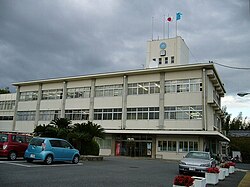
Kawaguchi is a city located in Saitama Prefecture, Japan. As of 1 January 2021, the city had an estimated population of 607,373 in 293,582 households and a population density of 9800 persons per km². The total area of the city is 61.95 square kilometres (23.92 sq mi). It is the Greater Tokyo Area's 8th most populated city, and second largest in Saitama Prefecture, after eponymous Saitama.

Ōmihachiman is a city located in Shiga Prefecture, Japan. As of 31 August 2021, the city had an estimated population of 82,233 in 34747 households and a population density of 570 persons per km2. The total area of the city is 76.97 square kilometres (29.72 sq mi).
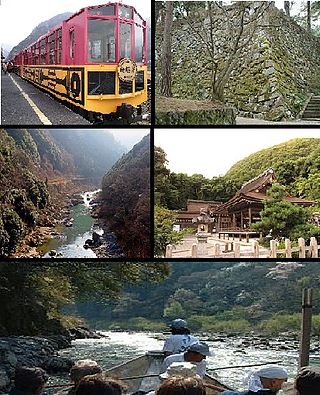
Kameoka is a city in Kyoto Prefecture, Japan. As of 1 January 2022, the city had an estimated population of 87,518 in 29,676 households and a population density of 390 persons per km2. The total area of the city is 224.80 square kilometres (86.80 sq mi).

Nagaokakyō is a city located in Kyoto Prefecture, Japan. As of 1 September 2023, the city has an estimated population of 82,279 in 37718 households and a population density of 4700 persons per km2. The total area of the city is 19.17 square kilometres (7.40 sq mi).

Suita is a city located in Osaka Prefecture, Japan. As of 31 March 2023, the city had an estimated population of 381,238 in 182636 households and a population density of 11,000 persons per km2. The total area of the city is 36.09 square kilometres (13.93 sq mi). It is a suburban city of Osaka City and a part of the Kyoto-Osaka-Kobe metropolitan area.
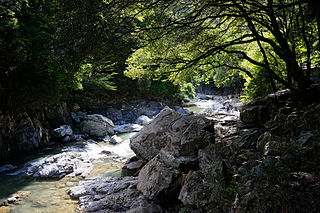
Takatsuki is a city in Osaka Prefecture, Japan. As of 31 March 2023, the city had an estimated population of 348,020 in 164,494 households and a population density of 3.300 persons per km2. The total area of the city is 105.29 square kilometres (40.65 sq mi).

Ibaraki is a city in Osaka Prefecture, Japan. As of 31 March 2023, the city had an estimated population of 285,224 in 132,300 households and a population density of 3,700 persons per km2. The total area of the city is 76.49 square kilometres (29.53 sq mi). It is a suburban city of Osaka City and a part of the Kyoto-Osaka-Kobe metropolitan area.

Habikino is a city located in Osaka Prefecture, Japan. As of 31 January 2022, the city had an estimated population of 109,479 in 50918 households and a population density of 4100 persons per km2. The total area of the city is 26.45 square kilometres (10.21 sq mi). The city is known for its grapes, and also for its large number of ancient kofun burial mounds. The city is also sometimes referred to by its former name Minami-Osaka (南大阪).

Nishinomiya is a city located in Hyōgo Prefecture, Japan. As of 1 November 2022, the city had an estimated population of 484,368 in 218,948 households and a population density of 4,800 persons per km². The total area of the city is 99.98 square kilometres (38.60 sq mi). Nishinomiya is an important commercial and shipping city in the Kansai region with the third largest population in Hyōgo Prefecture. Nishinomiya is best known as the home of Koshien Stadium, where the Hanshin Tigers baseball team plays home games and where Japan's annual high school baseball championship is held.

Tatsuno is a city in Hyōgo Prefecture, Japan. As of 31 May 2022, the city had an estimated population of 74,414 in 31119 households and a population density of 6200 persons per km2. The total area of the city is 49.42 square kilometres (19.08 sq mi).

Takarazuka is a city located in Hyōgo Prefecture, Japan. As of 1 February 2024, the city had an estimated population of 221,846 in 96,729 households and a population density of 2,200 persons per km². The total area of the city is 101.80 square kilometres (39.31 sq mi). Known as the "inner parlor" of Kansai, Takarazuka is famous for the Takarazuka Revue, hot springs, and the Takarazuka Tourism Fireworks Display held since 1913. It is also famous as a choice residential area along with Ashiya and Nishinomiya.
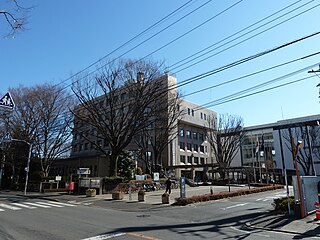
Higashimurayama is a city located in the western portion of the Tokyo Metropolis, Japan. As of 1 March 2021, the city had an estimated population of 148,275, and a population density of 8700 persons per km2. The total area of the city is 17.14 square kilometres (6.62 sq mi).

Nagaoka-kyō (長岡京) was the capital of Japan from 784 to 794. Its location was in Otokuni District, Yamashiro Province, corresponding to a 4.3 x 5.3 kilometer area spanning the borders of modern cities of Mukō and Nagaokakyō, Kyoto, the town of Ōyamazaki, and the Nishikyō-ku ward of the city of Kyoto. The ruins of the palace have been found in the Kaidecho neighbourhood of the city of Mukō and have been designated as a National Historic Site since 1964, with the area under protection expanded in 2016.

Mukōmachi Station is a passenger railway station located in the city of Mukō, Kyoto Prefecture, Japan. It is operated by the West Japan Railway Company. Mukōmachi Station is one of three railway stations in the city of Mukō; the others are Nishi-Mukō and Higashi-Mukō stations on the Hankyu Kyoto Line.

Nagaokakyō Station is a passenger railway station located in the city of Nagaokakyō, Kyoto Prefecture, Japan, operated by the West Japan Railway Company. Nagaokakyō Station is one of the two railway stations in the city of Nagaokakyō. The other is Nagaoka-Tenjin Station on the Hankyu Kyoto Line.

Nagaoka-Tenjin Station is a passenger railway station located in the city of Nagaokakyō, Kyoto Prefecture, Japan. It is operated by the private transportation company, Hankyu Railway.

Nishi-Mukō Station is a passenger railway station located in the city of Mukō, Kyoto Prefecture, Japan. It is operated by the private railway operator Hankyu Railway.
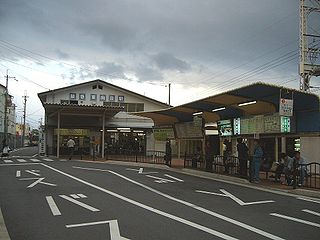
Higashi-Mukō Station is a passenger railway station located in the city of Mukō, Kyoto Prefecture, Japan. It is operated by the private transportation company, Hankyu Railway.

Mukonosō Station is a passenger railway station located in the city of Amagasaki, Hyōgo Prefecture, Japan. It is operated by the private transportation company Hankyu Railway.

Nishiyama-Tennōzan Station is a passenger railway station located in the city of Nagaokakyō, Kyoto, Japan. It is operated by the private railway operator Hankyu Railway.
